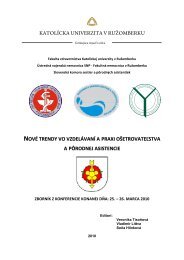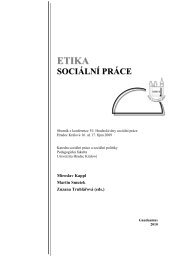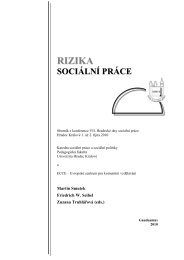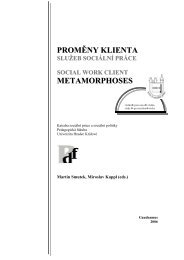Zmena klÃmy â možný dopad (nielen) na obyvateľstvo - Prohuman
Zmena klÃmy â možný dopad (nielen) na obyvateľstvo - Prohuman
Zmena klÃmy â možný dopad (nielen) na obyvateľstvo - Prohuman
Create successful ePaper yourself
Turn your PDF publications into a flip-book with our unique Google optimized e-Paper software.
changes? Or maybe they have already become the indicator of climatic catastrophe?<br />
What is climatic catastrophe and how does it manifest itself?<br />
This concept, expressed alike in numerous languages, means simply the cataclysm<br />
in existing climate. What is catastrophe, then? The word is of Greek origin<br />
(katastrophē – “overthrow”) and, according to Merriam-Webster Dictio<strong>na</strong>ry<br />
it means “a violent and sudden change in a feature of the earth” The definition<br />
emphasizes the suddenness as a major feature of catastrophe so the question<br />
may be raised whether the expected climate changes will happen rapidly. In attempting<br />
to answer this, it is proper to investigate the history of climate from<br />
the last 100–200 years, as the knowledge of the changes that happened during<br />
those times is quite broad, since instrumental observations have been available<br />
(Burroughs 2009). Figure 1 shows variability of average temperature of the air in<br />
winter (December–February) on the weather station at Krakow – Observatory. It<br />
has the longest continuous record of temperature in Poland, which is an excellent<br />
representation of the climatic conditions for the southern part of the country. The<br />
data demonstrates a great variability of the values and an increasing long-term<br />
trend. Similar graph shows global annual average temperature in 1861–2010 (fig.<br />
2). Although it shows the average deviation from mean temperature of 1961–1990<br />
period, it clearly proves that the global annual mean temperature increased about<br />
0.7°C. From climatologic point of view, it is rather alarming growth and if this<br />
trend continued for the next 100–300 years, the climatic changes, including global<br />
warming, would be catastrophic (rapid retreat of glaciers, sea level rise, changes<br />
in climate and vegetation zones, etc.).<br />
Climate changes, and especially air temperature vacillation can be examined<br />
thanks to proxy data, although this may result in poorer exactness. Many researchers,<br />
including geologists, glaciologists, botanists, historians, and archaeologists,<br />
provide priceless climatic data, which allows to reconstruct the past in<br />
historical or geologic time scale. The outcomes are generally known and u<strong>na</strong>mbiguous:<br />
they confirm considerable climate vacillations in the past ages, and also<br />
indicate that the difference between the highest and lowest annual mean temperature<br />
values can reach even 10°C. It must be remembered though that these<br />
changes were gradual. It has been estimated that even during the most sudden<br />
cases of warming, the increase of annual average temperature was never greater<br />
than only tenths degree Celsius per century.<br />
All the data confirm unequivocally that climatic changes and variability were<br />
present in the Earth’s history and are currently in progress. The reconstructions<br />
oblige us to seek for the causes of the changes, but they also make it possible<br />
to model climate. In connection with what has already been discussed, and in<br />
103

















